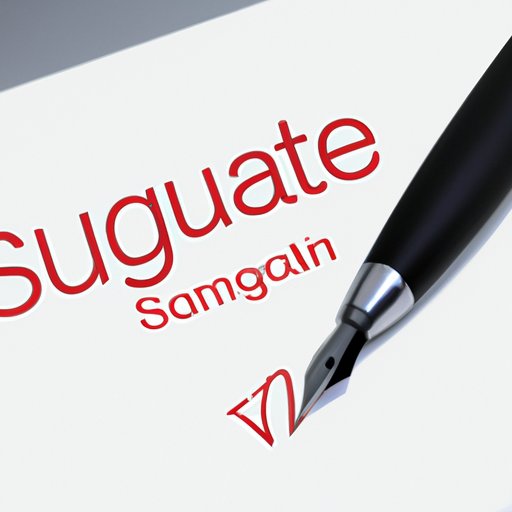
Introduction
In the digital age, electronic signatures have become an essential tool for individuals and businesses alike. An electronic signature, also known as a digital signature, is a way to indicate your acceptance or approval of an electronic document. With electronic signatures, you can sign a document online, which can save you time and effort. In this article, we will show you step-by-step how to create an electronic signature and explore its benefits.
Step-by-Step Guide to Creating an Electronic Signature
Before we dive into the process of creating an electronic signature, let’s first define what an electronic signature is and why it’s important. An electronic signature is a digital version of your signature, and it is legally binding. Electronic signatures help to streamline workflows and simplify the signing process. They are also secure since they involve encryption and authentication measures.
Now, let’s explore the step-by-step process of creating an electronic signature:
1. Choose an e-signature software: You’ll need to choose an e-signature software that you feel comfortable using. There are many options out there, like HelloSign, DocuSign, and Adobe Sign.
2. Upload your document: Once you’ve created your e-signature account, upload the document you need to sign online.
3. Add your signature: The e-signature software will prompt you to add your signature to the document. You can do this by using your computer’s trackpad or mouse. Alternatively, you can draw your signature using your finger if you’re using a touchscreen device like a tablet or smartphone.
4. Save and send: Once you’ve added your signature, save the document and send it back to the sender.
We recommend using a well-established e-signature software that is user-friendly and has a good reputation. Using a reliable e-signature software can save you time and help you create professional-looking documents that can be easily shared and signed online.
Explaining the Benefits of Electronic Signatures
Now that we have covered the process of creating an electronic signature, let’s dive into the benefits of using electronic signatures.
1. Cost-effective: One of the most significant benefits of using electronic signatures is that it is cost-effective. You don’t have to print out a document, sign it, scan it, and then email it back to the sender. This process is not only time-consuming, but it also involves using paper and ink. Electronic signatures eliminate the need for printing, scanning, and mailing documents, which can save both time and money.
2. Security: Electronic signatures are highly secure and offer more protection than traditional paper signatures. E-signature software includes encryption and authentication measures that ensure that your document is safe from tampering.
3. Convenience: Electronic signatures are incredibly convenient since you can sign documents online from anywhere at any time. This feature is especially useful if you’re working remotely or collaborating with team members who are situated in different locations.
4. Productivity: Electronic signatures are a significant productivity booster, especially for businesses. Since you don’t have to print, sign, and scan documents, you can get more done in less time.
5. Environmentally-Friendly: The paperless nature of electronic signatures is environmentally friendly since it reduces paper usage.
Comparison of Electronic Signature Software
Now that we’ve covered the benefits of using electronic signatures let’s compare various e-signature software available in the market.
1. HelloSign: HelloSign has an intuitive and straightforward interface that makes it easy to use. Its pricing model is flexible and affordable, and it offers many features that cater to both individuals and businesses.
2. DocuSign: DocuSign is an excellent e-signature software that is widely used by businesses worldwide. It is secure and reliable, and it integrates with many other software applications, making it a versatile option.
3. Adobe Sign: Adobe Sign is a comprehensive e-signature software that offers many features that cater to the needs of businesses. It integrates with Adobe Acrobat, which can be helpful if you work with PDF documents regularly.
It’s essential to review the features and pricing of each e-signature software before choosing the right one.
Comparison Table of E-Signature Software
| Software | Features | Pricing |
| — | — | — |
| HelloSign | Intuitive interface, flexible pricing, caters to individuals and businesses | Starts at $13 per month |
| DocuSign | Reliable and widely used, integrates with other software applications | Starts at $10 per month |
| Adobe Sign | Comprehensive software, integrates with Adobe Acrobat | Starts at $9.99 per month |
Personalization of Electronic Signatures
Personalizing an electronic signature can make it more meaningful and unique. Here are some tips on how you can personalize your e-signature:
– Experiment with different fonts: Try out different font styles and sizes before selecting the one that represents you best.
– Add an image or icon: You can add an image or icon to your e-signature that aligns with your profession or industry. Adding an image or icon can also help to differentiate your signature from others.
Here are some examples of personalized digital signatures:
Example 1

Example 2

Use Cases: When and Why to use Electronic Signatures
Now that we have covered how to create and personalize electronic signatures let’s dive into the use cases where e-signatures come in handy:
1. Contracts: One of the most common use cases for electronic signatures is for signing contracts. E-signatures are legally binding, and they offer a secure and efficient way to sign contracts online.
2. Agreements: Electronic signatures can be used to sign various types of agreements, such as employment agreements, non-disclosure agreements, and lease agreements, to name a few.
3. Purchase orders: Electronic signatures can significantly streamline workflows when it comes to purchase orders. E-signatures can help businesses save time, money, and resources when completing sales transactions.
While e-signatures are advantageous for many use cases, they may not be applicable in all situations. It’s essential to evaluate each use case carefully before deciding if e-signatures are the right solution.
Conclusion
In conclusion, electronic signatures are an invaluable tool that can significantly streamline workflows and boost productivity. In this comprehensive guide, we have covered various topics, from creating electronic signatures to personalizing them, and exploring their benefits and use cases. We hope this guide has provided you with the knowledge and motivation to embrace the benefits of electronic signatures.




